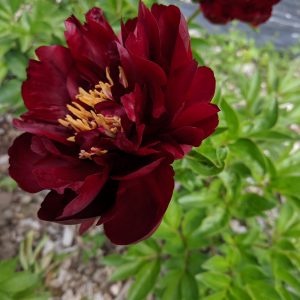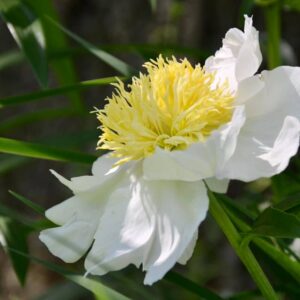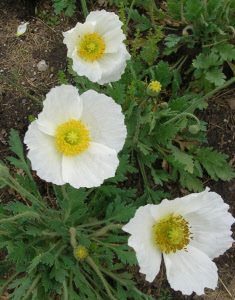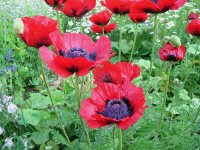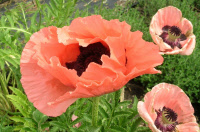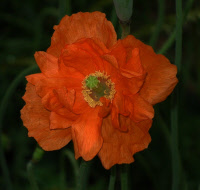Shop
Showing 537–544 of 788 results
-
Paeonia lactiflora Buckeye Belle Z 3-8
Semi-double, velvety blossoms of the deepest red, almost chocolate, with large outer petals surrounding narrow inner petals sprinkled with sparkling golden staminodes.
Semi-double, velvety blossoms of the deepest red, almost chocolate, with large outer petals surrounding narrow inner petals sprinkled with sparkling golden staminodes.
Size: 18-24” x 24-30”
Care: Full sun or part shade in most, well-drained soil
Wildlife Value: Deer and Rabbit resistant, attracts butterflies & hummingbirds, great cut flower
Awards: American Peony Society Gold Medal, American Peony Society Award for Landscape MeritHybridized in the USA in 1956 by Walter Mains
-
Paeonia lactiflora x Jan Van Leeuwen Z 3-8
Fragrant cupped single white blooms with yellow stamens
OUT OF STOCK
Fragrant cupped single white blooms with yellow stamens
Size: 2' x 3'
Care: Full sun in moist well-drained soil. Deer and rabbit resistant
Native: Japan
Wildlife Value: birds and ants enjoy the sweet nectar on the buds before openingIntroduced in 1928
-
Papaver anomalum alba Z 5-9
Paper thin petals on this pure white poppy with yellow stamens blooms May to October except in the heat of July.
Paper thin petals on this pure white poppy with yellow stamens blooms May to October except in the heat of July.
Size: 12” x 8”
Care: sun to part shade in well-drained soil. Deer resistant
Native: European AlpsAnomalum means extraordinary and this poppy is. Collected by 1909.
-
Papaver bracteatum Great scarlet poppy Z 5-8
Glossy fire engine red petals with black heart
OUT OF STOCK
Available for purchase in Spring only
Glossy fire engine red petals with black heart in June. D.M. Ferry Catalog, 1876: ”great beauty and magnificent.”
Size: 3-4’ x 3’
Care: sun in well-drained soil. Foliage dies back in summer & reemerges in the cool autumn. Drought tolerant and deer resistant.
Native: Siberia & Northern IranPapaver bracteatum was introduced to European gardens in 1817 from its native Siberia. Poppies have been grown since at least the time when Homer wrote the Illiad, in which he used the poppy’s hanging bud as a metaphor for a dying soldier. During World War I, Canadian soldier John McCrae again united the poppy with dying soldiers. He wrote “In Flanders’ Field.”
-
Papaver orientale ‘Beauty of Livermere’ Z 3-9
Glossy fire engine red petals with black heart in June.
ARCHIVED
Note: This is a plant not currently for sale. This is an archive page preserved for informational use.
Scarlet, tissue-thin petals surround a purple blotch at the base highlighted with purple stamens
Size: 3' x 2'
Care: sun in well-drained soil. Foliage dies back in summer & reemerges in the cool autumn.
Wildlife Value: Attracts hummingbirds, bees & butterflies. Deer & rabbit resistant.This red selection listed in Matineau’s book 1910
-
Papaver orientale ‘Princess Victoria Louise’ Poppy Z 3-7
crinkled, crepe-paper like apricot-pink petals
ARCHIVED
Note: This is a plant not currently for sale. This is an archive page preserved for informational use.
Dramatic, crinkled, crepe-paper like apricot-pink petals with black blotch in center – June. It is an ephemeral, like a tulip; it all disappears in summer and then the leaves reappear in late fall, so don’t be surprised.
Size: 24-30” x 18”
Care: sun in well-drained soilPoppies have been grown since at least the time when Homer wrote the Illiad, in which he used the poppy’s hanging bud as a metaphor for a dying soldier. French botanist Tournefort discovered the classic orange poppy, P. orientale in Armenia in 1714 and sent it to the King of France. This cultivar of the Oriental poppy in gardens since 1908. Princess Victoria Louise (1892-1980) was the only daughter of William II, German Emperor and Empress Augusta Victoria of Prussia and the maternal grandmother of Queen Sophie of Spain and former King Constantine II of the Hellenes. By marriage she was the Duchess of Brunswick. She was a beauty and the flower is aptly named.
-
Papaver orientale Poppy Z 2-7
The classic poppy - papery tabasco petals with black blotch center in June. D.M. Ferry Catalog, 1876:"great beauty and magnificent.” It appears to die back in summer then the leaves reappear in fall.
Available for purchase in Spring only
The classic poppy – papery tabasco petals with black blotch center in June. D.M. Ferry Catalog, 1876: ”great beauty and magnificent.” It appears to die back in summer then the leaves reappear in fall.
Size: 2-3’ x 2’
Care: Full sun in well-drained soil.
Native: Caucasus
Wildlife Value: Deer resistant.Poppies have been grown since at least the time when Homer wrote the Illiad, in which he used the poppy’s hanging bud as a metaphor for a dying soldier. During World War I, Canadian soldier John McCrae again united the poppy with dying soldiers. He wrote “In Flanders’ Field.”
French botanist Joseph Pitton Tournefort (1656-1708) discovered this in Armenia in 1714 and sent it to the King of France. In 1741 Englishman Peter Collinson sent seeds to John Bartram who cultivated the plant in his Philadelphia nursery. Jefferson grew the oriental poppy at Monticello and Washington grew it at Mount Vernon. Acc’d to the Gardeners Dictionary, 1768 “There are two or three varieties of this which differ only in the colour of their flowers … and a double flower of this kind … Tournefort says, the Turks eat the green heads of this Poppy, although they are very bitter and acrid.” -
Papaver rupifragum Spanish poppy Z 5-9
Small crinkled, crepe-paper like apricot petals all summer & fall except for a recess in the heat of July. If you let them go to seed they will make more plants and you’ll be glad for it.
Small crinkled, crepe-paper like apricot petals all summer & fall except for a recess in the heat of July. If you let them go to seed they will make more plants and you’ll be glad for it.
Size: 12-18" x 8"
Care: sun in well-drained to moist well-drained soil. Deer resistant, drought tolerant
Native: Spain, Asia Minor & CaucasusFirst described in Journal of Botany in 1873. Louise Beebe Wilder considered this among her favorite perennials. (1918). One of our favorites too! Gertrude Jekyll, mother of the mixed perennial border planted this for its “rich apricot color.” (1908).

